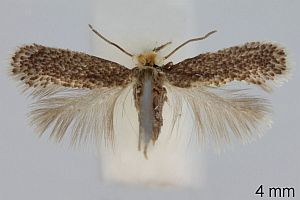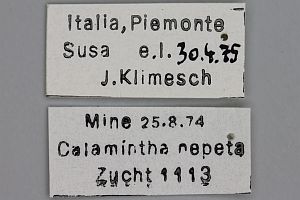

 +8Kontinente:EU
+8Kontinente:EU3. Biologie
3.1. Nahrung der Raupe
- [Lamiaceae:] Clinopodium menthifolium [= Calamintha sylvatica, Satureja sylvatica, Satureja calamintha] (Wald-Bergminze)
- [Lamiaceae:] Calamintha nepeta (Kleinblütige Bergminze)
- [Lamiaceae:] Micromeria sp.
[Bladmineerders.nl] führt als Raupennahrung Kleinblütige Bergminze (Calamintha nepeta), Wald-Bergminze (Clinopodium menthifolium = Calamintha sylvatica, Satureja sylvatica) und die nahe verwandte Gattung Micromeria an, also ausschließlich eine kleine Gruppe der Lippenblütler (Lamiaceae). Parenti (1963) gibt in seiner Erstbeschreibung Satureja calamintha an (ein weiteres Synonym von Clinopodium menthifolium).
4. Weitere Informationen
4.1. Etymologie (Namenserklärung)
Die Art ist nach der Raupennahrungspflanze benannt, für die Parenti (1963) den Namen Satureja calamintha verwendete.
4.2. Andere Kombinationen
- Stigmella saturejae Parenti, 1963 [Originalkombination]
- Trifurcula saturejae (Parenti, 1963) [bis Nieukerken et al. (2016) übliche Kombination]
4.3. Taxonomie
Nieukerken et al. (2016) überführen Glaucolepis von einer Untergattung von Trifurcula in eine eigenständige Gattung, die sie Trifurcula als Schwestergattung gegenüberstellen.
Die Art wurde kurzzeitig als Unterart bzw. Synonym von Glaucolepis hamirella angesehen. Angesichts großer genetischer Unterschiede scheint eine Trennung auf Artebene aber angebracht. Nieukerken et al. (2016) vermerken dazu: "The holotype of G. hamirella is very similar to male G. saturejae (Figs 80–85), and a synonymy was considered. However, DNA barcodes of Italian populations are very different from those from Morocco, Cyprus and Turkey together, and both clusters show again a lot of variation. A detailed morphological and molecular study is required to solve the status of this complex and until then we keep the species separate. Since the type of G. hamirella is from North Africa and saturejae from northern Italy, we consider the Turkish/Moroccan cluster as G. hamirella, the others as G. saturejae. Some specimens of G. saturejae studied by EvN earlier may carry labels with the name Trifurcula hamirella."
Angaben zu "Trifurcula hamirella" aus Europa betreffen damit wahrscheinlich durchweg die (nach der derzeitigen Fassung) "echte" Glaucolepis saturejae - lediglich Zypern wird von der "echten" Glaucolepis hamirella besiedelt.
4.4. Faunistik
Nach der [Fauna Europaea, last update 29 August 2013, Version 2.6.2.] gibt es aus Europa Nachweise aus Spanien, Frankreich, Italien, Kroatien und Griechenland, dazu aus Korsika, Sizilien und den Dodekanesischen Inseln. Alle diese Angaben dürften sich auf die "echte" G. saturejae beziehen.
(Autor: Erwin Rennwald)
4.5. Typenmaterial
Parenti (1963): “Nel 1955 ho raccolto nei dintorni di Vacri, in Abruzzo, numerose foglie di Satureja calamintha L. occupate dalle larve di un microlepidottero. [...] Le larve che hanno prodotto queste mine sono state allevate in laboratorio ed hanno dato origine a sei adulti, un maschio e cinque femmine, di una nuova specie di Lepidottero Stigmellide del quale viene ora fornita la descrizone.”
Weil das Genital des einzigen Männchens bei der Präparation zerstört wurde, konnte Parenti nur die weiblichen Genitalien beschreiben.
4.6. Literatur
- Klimesch, J. (1976): Zur Genitalmorphologie und Lebensweise der Fedalima (Stigmella) saturejae (Parenti, 1963) (Lep., Nepticulidae). — Zeitschrift der Arbeitsgemeinschaft Österreichischer Entomologen 28 (1-3): 45-48. [PDF auf zobodat.at]
- Nieukerken, E.J. van, Doorenweerd, C., Hoare, R.J.B. & D.R. Davis (2016): Revised classification and catalogue of global Nepticulidae and Opostegidae (Lepidoptera, Nepticuloidea). — ZooKeys 628: 65–246. doi: 10.3897/zookeys.628.9799. [Open-access-Dokument auf pensoft.net und Zugang zum PDF]
- Erstbeschreibung: Parenti, U. (1963): Stigmella saturejae nuova specie di microlepidottero e la sua mina. — Bollettino di Zoologia agraria e di Bachicoltura, serie seconda 5: 101-105.













